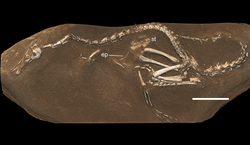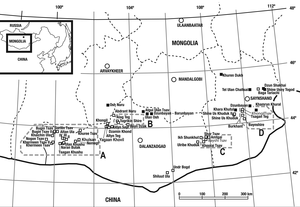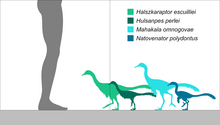Halszkaraptorinae
| Halszkaraptorines | |
|---|---|

| |
| Holotype specimen of Halszkaraptor escuilliei | |
| Scientific classification | |
| Domain: | Eukaryota |
| Kingdom: | Animalia |
| Phylum: | Chordata |
| Clade: | Dinosauria |
| Clade: | Saurischia |
| Clade: | Theropoda |
| Family: | †Dromaeosauridae |
| Subfamily: | †Halszkaraptorinae Cau et al., 2017 |
| Type genus | |
| † Halszkaraptor escuilliei Cau et al., 2017
| |
| Genera | |
| |
Halszkaraptorinae is a
Mahakala, and Hulsanpes. Halszkaraptorines are definitively known only from Late Cretaceous strata in Asia, specifically in Mongolia. Following the recent discovery of Natovenator, a member of the subfamily, the group is believed to have a semiaquatic
lifestyle.
History of discovery

The first known remains of halszkaraptorines were found in sandstone sediments in 1970 during a Polish-Mongolian expedition at the
Halszkaraptor escuilliei, in honor of Halszka Osmólska and François Escuillié, paleontologist that made negotiations for returning the poached specimen to Mongolia possible. With the naming of Halszkaraptor, the subfamily Halszkaraptorinae was also coined to contain this taxon and relatives, namely Hulsanpes and Mahakala.[3]
Description

Halszkaraptorines were relatively small theropods, reaching lengths similar to those of modern-day
metatarsal
III being unconstricted and markedly convex
anteriorly.[3]
Classification
Halszkaraptorinae is defined as the most inclusive clade that contains Halszkaraptor escuilliei but not Dromaeosaurus albertensis, Unenlagia comahuensis, Saurornithoides mongoliensis or Vultur gryphus.[3] The cladogram below is based on the phylogenetic analysis conducted in 2022 by Lee et al. in their description of Natovenator.[4]
Paleobiology

In 2017 a comparison of the fossils of Halszkaraptor with the
bipeds on land, but also swimmers that used its forelimbs to push through water and used their long necks for foraging. Such traits allowed them to exploit both terrestrial and aquatic paleoecosystems.[3]


